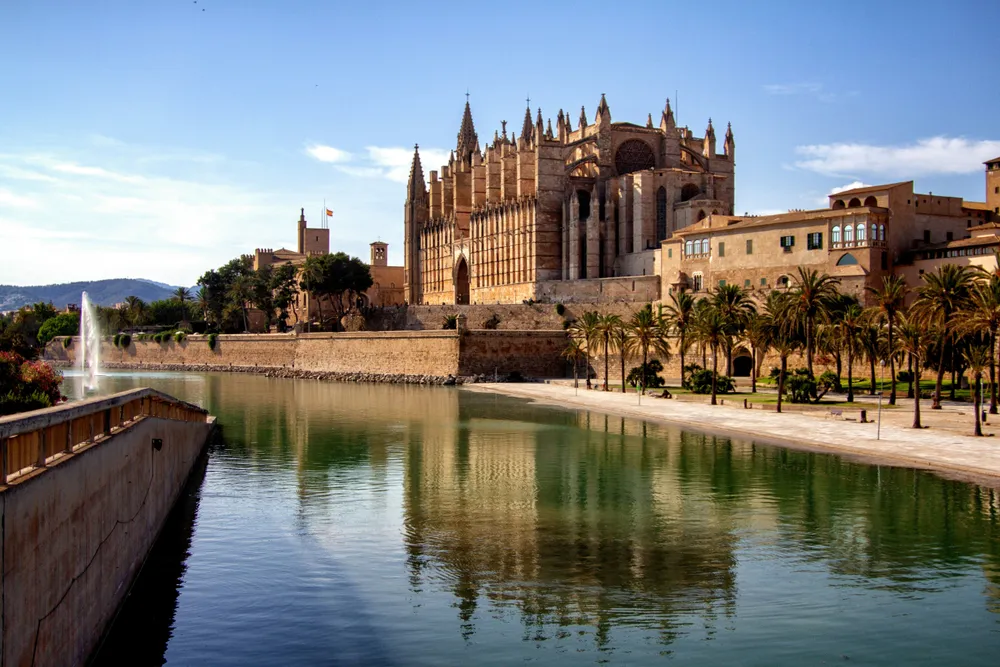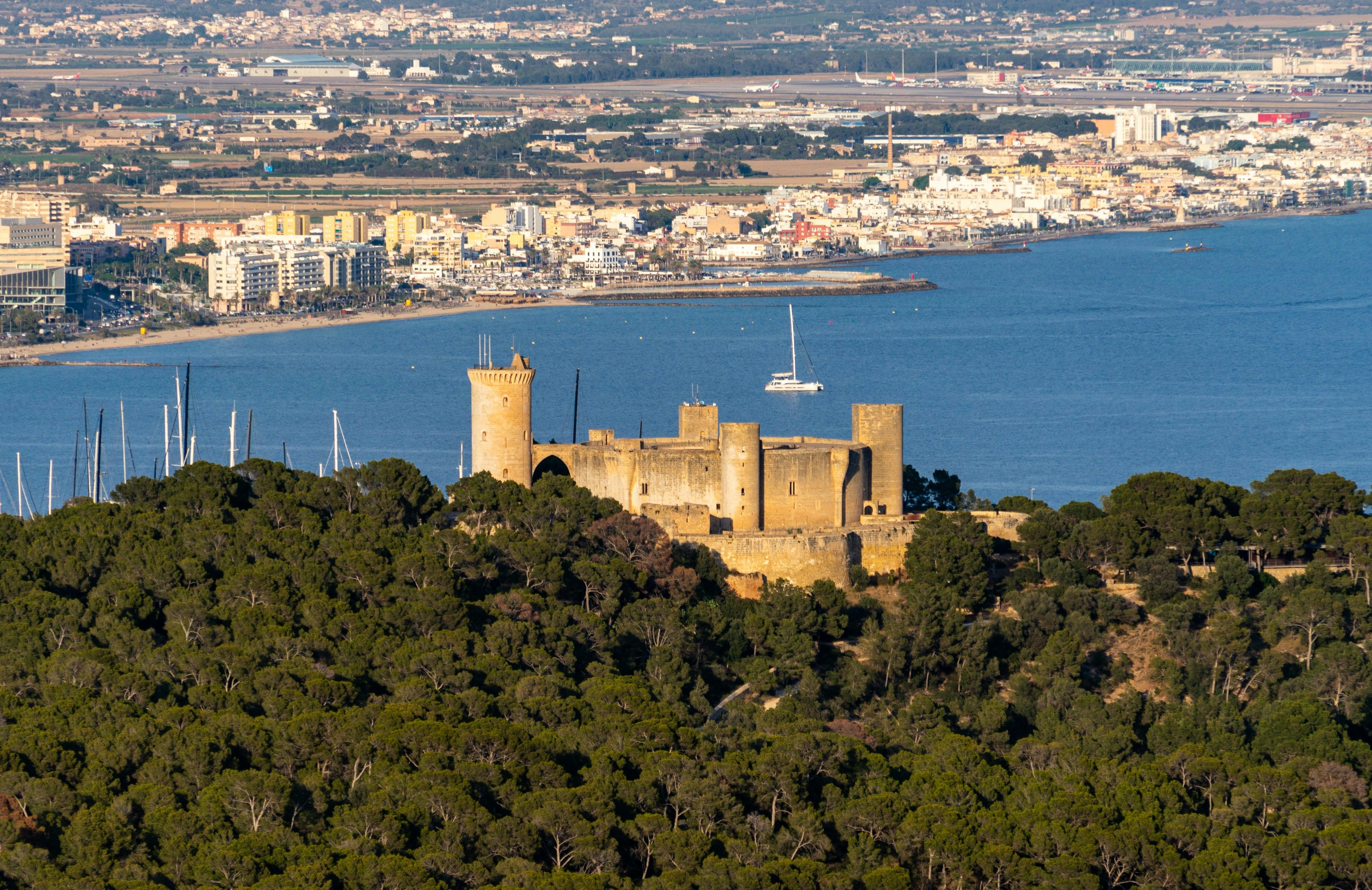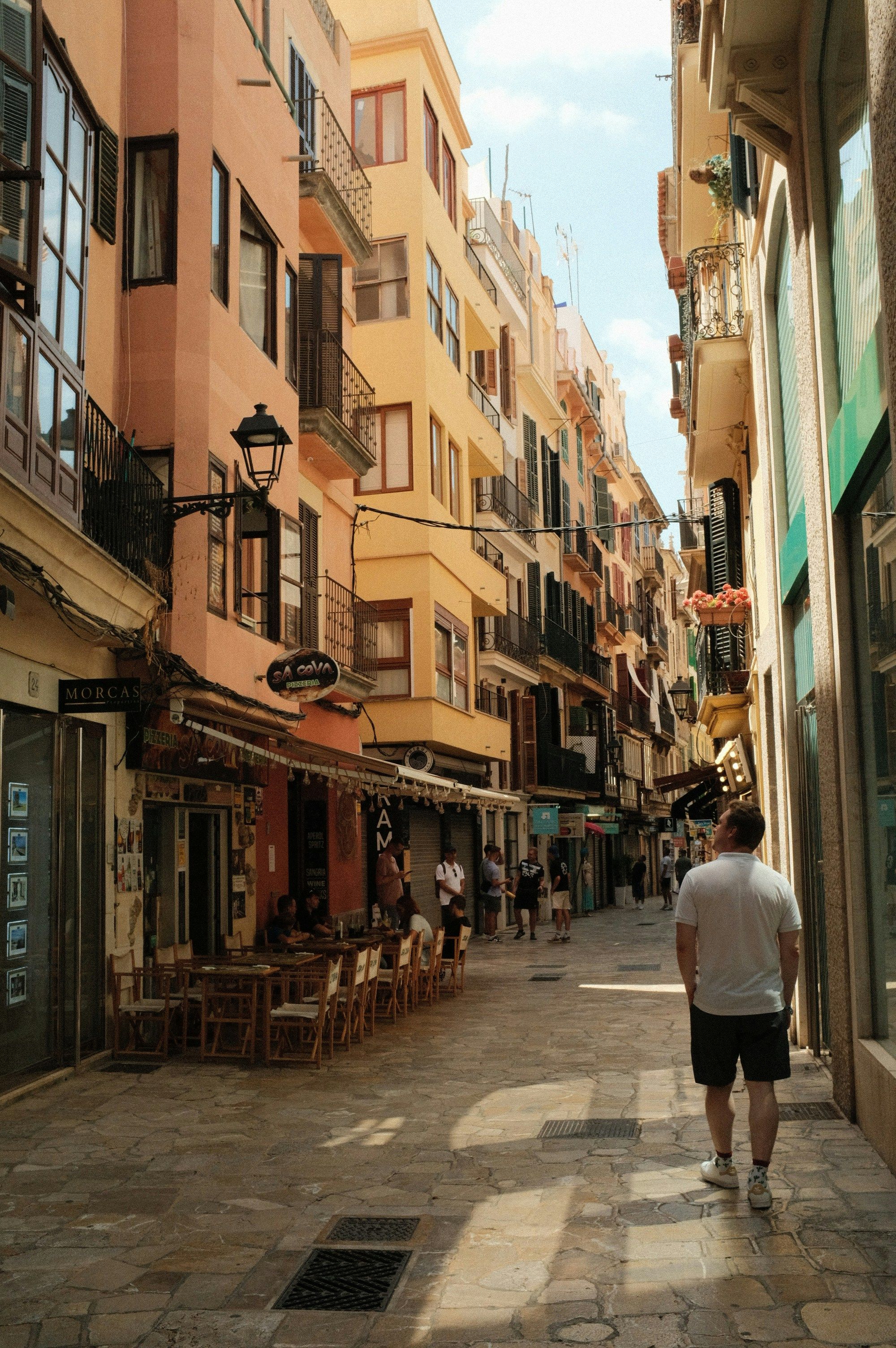Travelling from Denia to Palma: Complete Ferry & Travel Guide
Travel Guides
Travel Guides


Exploring the beautiful Mediterranean route from Denia on Spain's mainland to Palma on the stunning island of Mallorca is a popular journey for both tourists and locals alike. This 290.3 km sea crossing connects the Costa Blanca with the Balearic Islands, offering travellers a scenic maritime experience. Whether you're planning a holiday getaway, visiting family, or embarking on an island adventure, the Denia to Palma ferry route provides a convenient and enjoyable travel option. In this comprehensive guide, we'll explore everything you need to know about making this journey, including ferry schedules, port information, and what to expect when you arrive in the vibrant city of Palma.
When planning your journey from Denia to Palma, you have options to consider, though the ferry is the most direct route if you're starting in Denia.
The ferry route from Denia to Palma spans approximately 156.7 nautical miles (290.3 km) across the Mediterranean Sea. Operated by Balearia, this route offers a comfortable 5 hour and 15 minute journey, making it an efficient way to reach Mallorca while enjoying the sea views. With daily sailings (except on certain days), the ferry provides consistent service throughout the year, with approximately 30 sailings per month.
The average price for this crossing is around £410, which may vary depending on the season, how far in advance you book, and any additional services you select. While this might seem higher than some other Mediterranean ferry routes, it's important to consider that this is a substantial crossing that includes comfortable amenities and the convenience of bringing your vehicle if needed.
The ferry experience offers unique advantages over flying, including the ability to bring your car, more generous luggage allowances, and the pleasure of watching the coastline recede as you head out to sea. Many travellers find the journey itself to be part of the holiday experience, with time to relax, enjoy a meal, or simply soak in the Mediterranean atmosphere.
You can take a ferry from Denia to Palma. Ferries sail in around 5h 15m with about 1 sailing a day. The fastest ferry sails in around 5h 15m and is provided by Balearia. Ferry prices can range around £410 depending on time of year. Departures start at 17:00, with the last departure from Denia to Palma also at 17:00.
Balearia is the primary operator on this route, offering modern vessels equipped with various amenities to make your journey comfortable. Their ferries typically feature restaurants, cafés, shops, comfortable seating areas, and sometimes entertainment options. Many vessels also offer different accommodation options for longer journeys, though this particular crossing is typically completed within a day.
Onboard, you can expect to find:
The Denia to Palma route operates year-round, with 6 sailings per week, resulting in approximately 30 sailings per month. While summer months typically see higher demand due to tourism, the consistent schedule throughout the year makes this a reliable transportation option regardless of when you're travelling.
If you're planning to take your vehicle, Balearia accommodates cars, motorcycles, campervans, and bicycles. Vehicle transport allows for greater flexibility once you arrive in Mallorca, enabling you to explore the island at your own pace. Remember to book your vehicle space well in advance, especially during peak travel seasons.

Denia's port is conveniently located near the town centre, making it easily accessible for travellers. The port facilities are modern and well-organised, helping to ensure a smooth departure process.
To reach the port, you have several options:
At the terminal, you'll find essential services including ticket offices (though we recommend booking in advance), waiting areas, restrooms, and some shops and cafés. The port is relatively compact compared to larger ferry hubs, making it straightforward to navigate.
It's advisable to arrive at least 90 minutes before departure to allow time for check-in and boarding procedures, especially if you're travelling with a vehicle.
Palma's port is a larger facility that handles both ferry and cruise traffic. Upon arrival, you'll find yourself conveniently close to the city centre, with Palma's famous cathedral visible from many parts of the port.
From the port, you have multiple transportation options:
The port facilities include information desks, currency exchange, restrooms, and some shops and cafés. Signs are generally well-placed to direct you to transportation options and exit points.
For those continuing their journey to other parts of Mallorca, the port has good connections to the island's road network, making it easy to reach popular destinations like Alcúdia, Pollença, or Magaluf.
While the Denia to Palma ferry route makes it technically possible to visit Palma as a day trip, we generally don't recommend this approach due to the schedule constraints. With the ferry departing from Denia at 17:00 and the crossing taking 5 hours and 15 minutes, you would arrive in Palma at around 22:15, which doesn't leave any time for exploration on the same day.
For a proper visit to Palma, we recommend staying at least one night, preferably more. This allows you to experience the city's beautiful architecture, vibrant culture, and excellent cuisine without rushing. A more practical approach would be to take the ferry as the start of a multi-day visit to Mallorca.
If you're determined to maximise a short visit, consider taking the evening ferry from Denia, spending one full day in Palma, and then returning the following evening. This would give you approximately 24 hours to explore the city's highlights, though it would still be a somewhat rushed experience.
A better alternative for those with limited time might be to plan a 2-3 day trip, which allows for a more relaxed pace and the opportunity to see more of what both Palma and the surrounding areas of Mallorca have to offer.
Palma de Mallorca offers a wealth of attractions that blend historical significance with Mediterranean charm. Here are five must-see highlights:
This magnificent Gothic cathedral dominates Palma's skyline and waterfront. Built on the site of a former mosque, its spectacular rose window and Gaudí-influenced elements make it a must-visit. The cathedral is open Monday to Friday from 10:00 to 17:15, with adjusted hours on Saturdays and during religious ceremonies.
This unique circular castle sits on a hill overlooking the city and bay. Built in the 14th century, it's one of the few circular castles in Europe and offers spectacular panoramic views. Open Tuesday to Saturday from 10:00 to 19:00 and Sundays from 10:00 to 15:00.
Lose yourself in the maze of narrow, winding streets filled with boutiques, galleries, and cafés. The Arab Quarter is particularly atmospheric with its medieval architecture and hidden courtyards. This area can be explored any time, though shops typically open from 10:00 to 20:00.
Housed in a renovated 16th-century fortress, this museum features works by Picasso, Miró, and other Spanish and international artists. Open Tuesday to Saturday from 10:00 to 20:00 and Sundays from 10:00 to 15:00.
Palma's seafront promenade stretches for several kilometres, lined with restaurants, bars, and marinas filled with luxury yachts. It's perfect for a morning jog or evening stroll and connects many of the city's main attractions. Accessible 24 hours, though it's most lively in the evenings.

Palma offers distinct areas that each provide a different experience of the city:
La Lonja: The old fishing quarter is now a vibrant nightlife district with tapas bars and restaurants housed in historic buildings. It comes alive in the evenings and offers some of the best dining experiences in the city.
Santa Catalina: Once a fishermen's quarter, it's now a trendy area with a fantastic food market, international restaurants, and boutique shops. The market is especially worth visiting in the morning when it's bustling with activity.
Paseo del Borne: Palma's golden mile for shopping, featuring designer boutiques and luxury brands in an elegant tree-lined avenue. The perfect place for those looking to indulge in some retail therapy.
El Terreno: Currently undergoing regeneration, this hillside neighbourhood offers spectacular views and is home to many of Palma's music venues and clubs.
Palma enjoys a classic Mediterranean climate with hot, dry summers and mild, slightly wetter winters, making it a year-round destination with over 300 days of sunshine annually.
Summer (June to August) brings temperatures averaging 25-30°C, perfect for beach activities and outdoor dining. These months see minimal rainfall and long daylight hours, though August can be particularly hot and humid.
Spring (March to May) and autumn (September to November) offer ideal conditions for exploring the city, with temperatures ranging from 15-25°C and fewer crowds. These shoulder seasons provide a perfect balance of pleasant weather and space to enjoy attractions without the summer crush.
Winter (December to February) remains mild compared to northern Europe, with daytime temperatures typically between 10-15°C. While this is the wettest season, rain tends to come in short bursts rather than prolonged periods, and many days remain sunny and bright.
Regarding ferry operations, the Mediterranean can experience strong winds occasionally, particularly during winter months, which might affect crossings. The Tramuntana (north wind) can create choppy conditions, though the large ferries on this route are designed to handle moderate sea conditions. During extreme weather, delays or cancellations are possible, though relatively rare.
Palma offers options for various budgets, though it tends to be more expensive than mainland Spain, particularly during peak summer months.
For budget travellers, expect to spend around £60-80 per day, including hostel accommodation (£20-30), budget meals (£5-10 per meal), and public transportation (£1.50 per bus journey). Many of Palma's attractions can be viewed from the outside for free, and beaches don't charge entry fees.
Mid-range travellers should budget approximately £120-180 daily, covering a decent hotel room (£80-120), restaurant meals (£15-25 per person), and perhaps a paid attraction or two (typically £5-15 each).
Luxury experiences in Palma can easily exceed £250 per day, with boutique hotels or sea-view rooms starting at £150, fine dining experiences from £50 per person, and activities like yacht charters or private tours.
Money-saving tips include:
The ideal time to visit Palma depends on your preferences, but many consider late spring (May-June) and early autumn (September-October) to offer the perfect balance of warm weather, fewer crowds, and reasonable prices.
Peak Season (July-August): Expect hot temperatures (often exceeding 30°C), crowded attractions, and premium prices for accommodation and ferry tickets. The city buzzes with energy, beach clubs are in full swing, and nightlife reaches its zenith. This period is ideal if you're focused on beach time and nightlife, but less so for cultural exploration.
Shoulder Season (May-June, September-October): These months offer warm, pleasant temperatures (20-25°C), significantly fewer crowds, and more reasonable prices. The sea remains warm enough for swimming, especially in September and early October. This period is perfect for combining cultural activities with some beach time.
Off-Peak (November-April): While cooler (10-18°C) and with occasional rainfall, this period offers a more authentic experience of local life. Many attractions remain open but with no queues, and accommodation prices drop significantly. The almond blossom in February creates spectacular landscapes across the island.
Palma hosts several noteworthy events throughout the year, including:
For those primarily interested in sightseeing and culture, we recommend visiting in May or October. Beach lovers will find September offers the perfect combination of warm sea temperatures and more space to spread your towel.

Finding the right accommodation in Palma is essential for making the most of your visit after arriving on the ferry from Denia. The city offers a diverse range of options to suit all budgets and preferences.
For those who want to be in the heart of the action, Palma's historic centre offers boutique hotels and apartments within walking distance of major attractions like the Cathedral and Plaza Mayor. Prices typically range from £80-£150 per night, with higher rates during summer months.
Families visiting Palma might prefer the Portixol or Ciudad Jardín areas, which offer more spacious accommodations and proximity to beaches. Vacation rentals and family-friendly hotels typically cost between £100-£200 per night, offering kitchen facilities and often swimming pools.
Solo travellers and budget-conscious visitors can find hostels and guesthouses starting from £25 per night in areas like El Terreno or slightly outside the city centre. These often include communal kitchens and social spaces, perfect for meeting fellow travellers.
We recommend booking your accommodation well in advance, especially if travelling during the peak summer season when Palma becomes particularly popular following the convenient Balearia ferry crossing from Denia.
After disembarking from your ferry at Palma's port, you'll find the city offers excellent transport options for exploring the island.
Palma boasts an efficient bus network with the EMT buses covering the city centre and surroundings. A single journey costs approximately £1.50, while a 10-trip card offers better value at around £10. The city also has a metro line connecting to the university and nearby towns.
Taxis are readily available throughout Palma, with standard rates starting at around £3.50 plus £1 per kilometre. Ride-sharing apps also operate in the city, often providing a more economical option for longer journeys.
For those wishing to explore Mallorca beyond Palma, car rentals start from approximately £30 per day. The island's well-maintained roads make driving straightforward, though parking in central Palma can be challenging during peak seasons.
Cycling is increasingly popular in Palma, with bike rental shops offering daily hires from around £10-15. The city's flat terrain and dedicated cycle paths make this an enjoyable way to explore.
Travelling from Denia to Palma by ferry offers a relaxing and scenic journey across the Mediterranean. With Balearia operating daily sailings departing at 17:00, you can enjoy a comfortable 5-hour and 15-minute crossing before arriving in beautiful Palma.
The route spans 156.7 nautical miles (290.3 km) and provides a unique opportunity to experience the beauty of the Mediterranean Sea. With six weekly sailings and approximately 30 monthly crossings, you'll have plenty of flexibility when planning your trip.
Remember that while the average fare is around £410, booking in advance can often secure better rates, especially during peak travel seasons. The ferry journey itself becomes part of your holiday experience, allowing you to arrive in Mallorca refreshed and ready to explore everything this stunning island has to offer.
Ready to experience this fantastic Mediterranean journey? Book your Denia to Palma ferry today and start planning your perfect Balearic Island adventure!